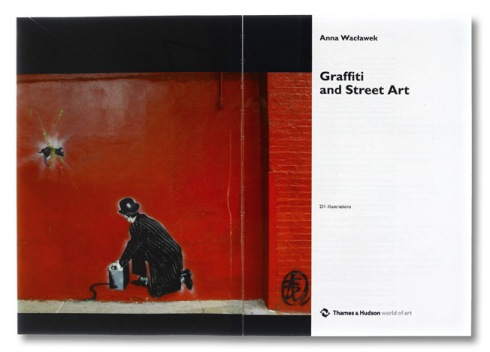All art history students would be familiar with the Thames & Hudson World of Art series. These paperback books with their black spines are authoritative accounts of various art movements, styles and histories. When Thames & Hudson launched its World of Art series in 1958 it aimed to produce low cost, high quality art books. Now with over 300 titles in the series ranging from Aboriginal Art to Internet Art it is not surprising that there is Anna Wacławek Graffiti and Street Art (Thames & Hudson, 2011, London).

In the book’s introduction Wacławek notes that: “a major study of graffiti and street art grounded in visual art analysis has yet to be published,” and that she intends this book to fill that gap. Most of the words about graffiti and street art have being written in sociology or criminology rather than from the discipline of visual arts. The lack of a serious book on the art of graffiti and street art is surprising given that in 1984 Thames and Hudson published the some of the first documentation of graffiti art, Martha Cooper and Henry Chalfant’s Subway Art. But Subway Art, like most of the earlier books on graffiti, is a collection of photographs.
Graffiti and Street Art certainly fills that gap. After reading so many short articles and interviews with artists it was relief to read in an organised and systematic order in one book rather than gleaming the same information from diverse sources. Wacławek’s precise language can pack many ideas into a single sentence. The many photographs in the book are used as examples and each one is referred to in the text.
The first question about such a book is if graffiti writers do not consider their work art then what is point of an art book is actually an irrelevant question. Apart from some contemporary English speaking artists the same can be said about almost everyone currently called an artist. But trivial categorisation disputes aside the art of graffiti needs to be included in this book. Describing the structure of graffiti writing and the genealogy of graffiti is necessary, at the very least to distinguish it from street art.
Later the question, ‘is graffiti art?’, allows Wacławek to distinguish art history from visual culture studies. Distinguish between art history and visual culture history removes the aura of excellence around in art history and allows the examination of popular images. This is an important distinctions not just for graffiti and street art but for any examination of popular images.
The popularity of graffiti and street art is not dismissed but examined. It is looked at in the collaboration of the public in the creation of street art. When Wacławek examines the dissemination of street art in photographs and online she raises the question: where do you see the most street art and graffiti on the streets or online?
Examining graffiti and street art from the perspective of art history is important that issues of style, subject and signature key to both art history and graffiti. Wacławek gives context to Haring and Basquiat as a sidetrack in the history of graffiti. There are also occasionally references to contemporary artists, like Andy Goldsmith, in perspective with street art
Sometimes I felt that Wacławek was being too subtle with both her arguments and the examples that accompanied them rather than doing something more obvious. Vexta and Nick Walker are the examples in the section titled “Identity Politics”. However, if the average reader can think of the more obvious arguments and examples is it necessary to writing them?
At the University of Melbourne has CCDP20001 Street Art can now be studied as part of the breadth subjects for undergraduates studying Science, Music, Commerce, Biomedicine and Arts. I am surprised that this book is not one of the prescribed texts.
The prescribed texts for the subject are:
Cubrilo, Duro et al (2010), King’s Way: The Beginnings of Australian Graffiti – Melbourne 1983-1993 (Melbourne: Melbourne University Press)
Schacter, Rafael (ed.) (2013) The World Atlas of Graffiti and Street Art (New Haven, CT: Yale University Press)
Alison Young’s Street Art, Public City: Law, Crime and the Urban Imagination.
Anna Wacławek Graffiti and Street Art is a book that is needed by the many high school students and university students who are and will be studying graffiti and street art.



January 23rd, 2016 at 8:38 AM
Thanks for the suggestion Mark, I would certainly agree that it’s a great resource for students ;)
January 23rd, 2016 at 9:02 AM
Cheers Anna, I got a lot of reading it.